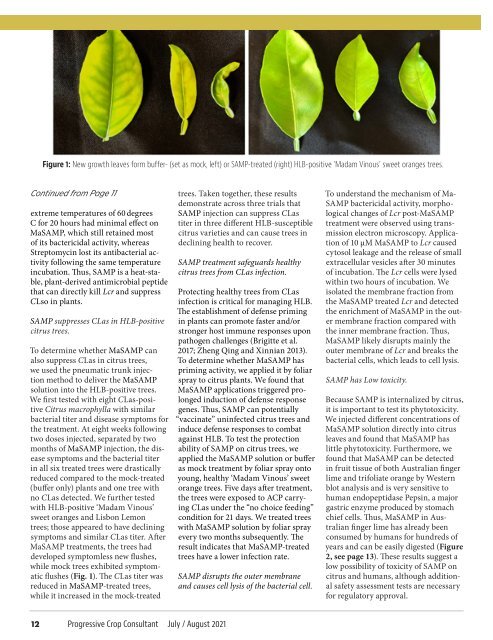PCC June July 2021 e
Create successful ePaper yourself
Turn your PDF publications into a flip-book with our unique Google optimized e-Paper software.
Figure 1: New growth leaves form buffer- (set as mock, left) or SAMP-treated (right) HLB-positive ‘Madam Vinous’ sweet oranges trees.<br />
Continued from Page 11<br />
extreme temperatures of 60 degrees<br />
C for 20 hours had minimal effect on<br />
MaSAMP, which still retained most<br />
of its bactericidal activity, whereas<br />
Streptomycin lost its antibacterial activity<br />
following the same temperature<br />
incubation. Thus, SAMP is a heat-stable,<br />
plant-derived antimicrobial peptide<br />
that can directly kill Lcr and suppress<br />
CLso in plants.<br />
SAMP suppresses CLas in HLB-positive<br />
citrus trees.<br />
To determine whether MaSAMP can<br />
also suppress CLas in citrus trees,<br />
we used the pneumatic trunk injection<br />
method to deliver the MaSAMP<br />
solution into the HLB-positive trees.<br />
We first tested with eight CLas-positive<br />
Citrus macrophylla with similar<br />
bacterial titer and disease symptoms for<br />
the treatment. At eight weeks following<br />
two doses injected, separated by two<br />
months of MaSAMP injection, the disease<br />
symptoms and the bacterial titer<br />
in all six treated trees were drastically<br />
reduced compared to the mock-treated<br />
(buffer only) plants and one tree with<br />
no CLas detected. We further tested<br />
with HLB-positive ‘Madam Vinous’<br />
sweet oranges and Lisbon Lemon<br />
trees; those appeared to have declining<br />
symptoms and similar CLas titer. After<br />
MaSAMP treatments, the trees had<br />
developed symptomless new flushes,<br />
while mock trees exhibited symptomatic<br />
flushes (Fig. 1). The CLas titer was<br />
reduced in MaSAMP-treated trees,<br />
while it increased in the mock-treated<br />
trees. Taken together, these results<br />
demonstrate across three trials that<br />
SAMP injection can suppress CLas<br />
titer in three different HLB-susceptible<br />
citrus varieties and can cause trees in<br />
declining health to recover.<br />
SAMP treatment safeguards healthy<br />
citrus trees from CLas infection.<br />
Protecting healthy trees from CLas<br />
infection is critical for managing HLB.<br />
The establishment of defense priming<br />
in plants can promote faster and/or<br />
stronger host immune responses upon<br />
pathogen challenges (Brigitte et al.<br />
2017; Zheng Qing and Xinnian 2013).<br />
To determine whether MaSAMP has<br />
priming activity, we applied it by foliar<br />
spray to citrus plants. We found that<br />
MaSAMP applications triggered prolonged<br />
induction of defense response<br />
genes. Thus, SAMP can potentially<br />
“vaccinate” uninfected citrus trees and<br />
induce defense responses to combat<br />
against HLB. To test the protection<br />
ability of SAMP on citrus trees, we<br />
applied the MaSAMP solution or buffer<br />
as mock treatment by foliar spray onto<br />
young, healthy ‘Madam Vinous’ sweet<br />
orange trees. Five days after treatment,<br />
the trees were exposed to ACP carrying<br />
CLas under the “no choice feeding”<br />
condition for 21 days. We treated trees<br />
with MaSAMP solution by foliar spray<br />
every two months subsequently. The<br />
result indicates that MaSAMP-treated<br />
trees have a lower infection rate.<br />
SAMP disrupts the outer membrane<br />
and causes cell lysis of the bacterial cell.<br />
To understand the mechanism of Ma-<br />
SAMP bactericidal activity, morphological<br />
changes of Lcr post-MaSAMP<br />
treatment were observed using transmission<br />
electron microscopy. Application<br />
of 10 μM MaSAMP to Lcr caused<br />
cytosol leakage and the release of small<br />
extracellular vesicles after 30 minutes<br />
of incubation. The Lcr cells were lysed<br />
within two hours of incubation. We<br />
isolated the membrane fraction from<br />
the MaSAMP treated Lcr and detected<br />
the enrichment of MaSAMP in the outer<br />
membrane fraction compared with<br />
the inner membrane fraction. Thus,<br />
MaSAMP likely disrupts mainly the<br />
outer membrane of Lcr and breaks the<br />
bacterial cells, which leads to cell lysis.<br />
SAMP has Low toxicity.<br />
Because SAMP is internalized by citrus,<br />
it is important to test its phytotoxicity.<br />
We injected different concentrations of<br />
MaSAMP solution directly into citrus<br />
leaves and found that MaSAMP has<br />
little phytotoxicity. Furthermore, we<br />
found that MaSAMP can be detected<br />
in fruit tissue of both Australian finger<br />
lime and trifoliate orange by Western<br />
blot analysis and is very sensitive to<br />
human endopeptidase Pepsin, a major<br />
gastric enzyme produced by stomach<br />
chief cells. Thus, MaSAMP in Australian<br />
finger lime has already been<br />
consumed by humans for hundreds of<br />
years and can be easily digested (Figure<br />
2, see page 13). These results suggest a<br />
low possibility of toxicity of SAMP on<br />
citrus and humans, although additional<br />
safety assessment tests are necessary<br />
for regulatory approval.<br />
12 Progressive Crop Consultant <strong>July</strong> / August <strong>2021</strong>

















